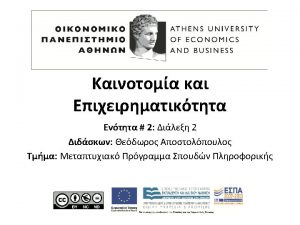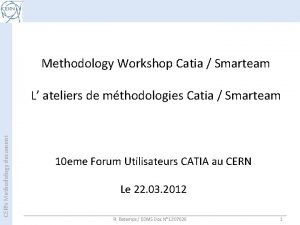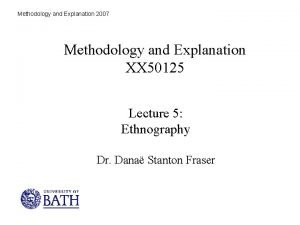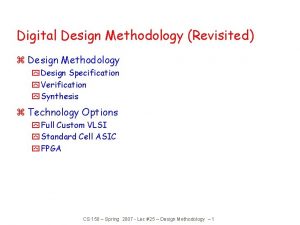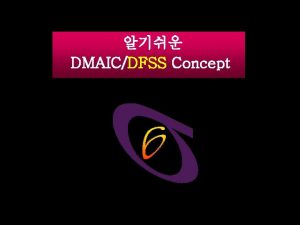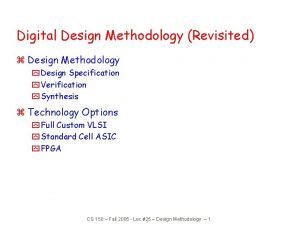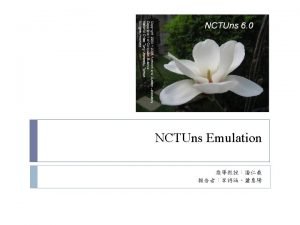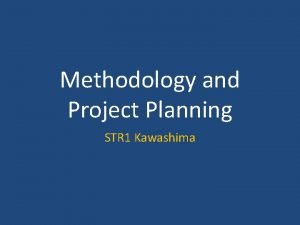Access Gap Study The Access Gap Model Methodology






































- Slides: 38

Access Gap Study The Access Gap Model Methodology, Analysis and Interim Outputs 21 st January 2016

Content • Overview of Access Gap Study and Objectives • Total ICT Market context – mobile, other wireless & • • • fibre The Model outlined Methodology The gaps defined USF resources, objectives and operating principles Interim outputs of the Model Next steps to USF Program Implementation 1

Study Objectives – Whole contract Approximately one year consultancy project to: • Phase 1 - Assess on a country-wide level the extent of communication coverage and the access levels achieved. § Engage with the industry and other stakeholders to secure coverage mapping, identify the gaps in service provision and costs § Create a GIS Portal and Access Gap Model • Phase 2 - Support implementation of initial USF network expansion projects § Grouping gap area projects into optimal lots – at sublocation or ward level - for purposes of tendering to service providers § Identify other gaps (e. g. , schools connectivity) for consideration and USF projects • Phase 3 - Provide long-term strategy and update USF’s Operating Manual 2

Overall scope of Work – Approx. 12 months Access Gap Study and USF Portal • Stakeholder Consultation • ICT Service Gap Analysis – Voice, Broadband data, Broadcasting, Post & Courier • Feasibility & Subsidy Model • GIS-driven Online and updatable Portal and Gap Model • Identify initial USF Subsidy Tender Lot Scenarios Program Development and Subsidy Competition Support • • Identify and Appraise Set of First Priority Investments Prepare Bidding Lot Specs and Documentation Assist on all Tender Milestones Assist with Subsidy awards and contracting USF Documentation & Operating Manual Update 3 • Provide USF Competition Templates • Provide 5 Year USF Implementation Strategy • Provide Monitoring Design • Review and revise Operating Manual

Phase 1 Schedule Week of 18 Jan 2016 • Data collection • GIS Coverage KNBS Data Overlay • Geo-area referenced Excel Gap Model initiated • Prototype Portal in process • Access Gaps Model providing initial subsidy and Bidding Lot Scenarios • Stakeholder Workshop • Receive stakeholder comments and inputs • • Final Access Gaps Model On-site Portal validation Final Portal in place USF Bidding Lot Scenarios developed and displayed • Final Access Gaps Report • Training of USF Personnel * Week of 15 Feb 2016 Week of 14 Dec 2015 * Staff training to take place immediate following Final Access Gap Report 4

Phase 2 Schedule – High Level (approximate) • • Viable Biding Lots developed Site visits & demand validation Project Appraisals Project Design & Planning Report • Industry Workshop • Stakeholder Report Week of 10 Oct 2016 • Develop Bidding Documents • Approve & Issue Bidding Documents • Pre-Bid Operators’ Meeting • Bid Evaluation Report • USF Subsidy Contract Awards Week of 23 May 2016 • USF Operating Manual reviewed and Revised • USF Contract Template • Monitoring Report • 5 -10 Year Implementation Strategy • Project Final Report • Final USF Workshop Week of 5 Dec 2016 Strong focus on needful and justifiable project development, prioritisation, transparency and consultant skills transfer to the Authority 5

The telecom market context – latest CA data • Mobile growth continued in Q 1 2015/16 • Traditional fixed services in decline • Fixed broadband now dominated by fibre as ADSL is reduced • § 4. 7% growth § 88%+ penetration § Usage at 99 min/month is vibrant & due to low tariffs & on-net incentives § Only marginal market share change § CDMA turned down Internet/Data Subscriptions § Fibre services provided by several operators Total Internet Subscriptions But Internet / data subscriptions dominated Mobile Data Subscriptions Terrestr. Wireless Data Subscriptions by the mobile operators Satellite Data Subscriptions § USF could expect mobile and wireless to offer Fixed DSL Data Subscriptions the most useful gap solution, but Fixed Fibre Data Subscriptions § Direct access to Fibre could also be included Fixed Cable Modem Subscriptions for a school connectivity program Total Internet Users 6 Sept 2015 21, 628, 271 21, 511, 638 13, 221 720 2, 500 100, 192 25 31, 985, 048

Understanding the voice and data gap • Kenya has very challenging demography Status in 2011: § 1, 119 sub-locations and 4. 48 Million people “without access” to mobile voice services § 6, 256 sub-locations and 72% of population without access to data (3 G) § This study shows the answer • How much have mobile operators expanded commercially? § GIS mapping in this study has assessed the situation § Useable service for a common signal level of -90 d. Bm has been mapped 7

The voice and data service gaps today Current 2 G mobile coverage (all operators) has reached 45% area and 94. 4% of the population 3 G coverage at 60%+ is still lagging even in many populous areas 8

The GIS Portal and Access Gap Model Display service and access gaps at ward & sub-location level Inform and enable Excel geo-area based project feasibility and subsidy model creation Enable USF project bids, lot boundaries, subsidy estimates & project specifications to be developed and displayed 9

The Access Gap Methodology Comprises two integrated components: A suite of GIS software Within the GIS Portal integrating GIS maps and other geo-referenced data into a single model showing the boundaries of counties, constituencies, wards and sublocations and population distribution, broadcast stations, post offices and schools Overlays the latest Q 4 2015 GIS 2 G & 3 G coverage prediction maps and fibre routes supplied by the operators Calculates the areas and populations covered and uncovered by 2 G and 3 G mobile signals A complex Excel spreadsheet Referenced to the GIS software Includes all demand cost assumptions relevant to the estimation of the commercial viability and subsidy requirements for providing services to the gap areas. 10

The Modelling process from input data to gap projects and subsidies • • • Populations based on 2009 Census upscaled to 2017 at 2. 6% per annum growth Population distribution within sub-locations is provided by Land. Scan dataset Mobile -90 d. Bm coverage prediction maps from the three operators for Q 4 2015 Inputs from KNBS, Operators and other infrastructure & service providers The GIS Portal Integrates all data and provides output to the Gap Model The Access Gap Financial Model Excel Spreadsheet Then displays the results 11 Gap projects and estimated Maximum Subsidies

Using Land. Scan to calculate population covered 12

Areas and populations covered calculated by the GIS individually for each sub-location 13

Summary of the 2 G Access Gap today Calculated by the GIS Portal software • • • 94. 4% of population covered 5. 6% unserved (2. 66 Million @ 2017 projection) 166 sub-locations with zero % coverage 418 sub-locations with less than 50% population coverage 5, 655 sub-locations 100% covered Sub-location population coverage Populations in uncovered sub-locations (no. of sub-locations with % covered) (at given percentages) 2, 661, 549 total unserved population (projected to 2017) 7, 149 total sub-locations 100% >90% >50% <50% 0% >90% 50 -90% < 50% 0% 5, 655 485 425 418 166 91, 126 523, 471 1, 347, 643 699, 310 14

The GIS-referenced Excel model The critical drivers for mobile expansion are: • • Uncovered areas & populations per sub-location from the GIS software How many new mobile base stations (BTSs) required – based on assumed tower height & coverage radius in the uncovered areas Demand side assumptions – user penetration and average revenue per user (ARPU) The cost side assumptions § Direct sales costs (% of revenues spent on customer acquisition & sales) § Base station CAPEX costs (towers, power supply, backbone transmission extension & electronic equipment) § Base station OPEX costs (equipment operation & maintenance, fuel and security) 15

All factors and GIS / Excel based activities 16

Model assumptions Assumptions Exchange rate: USD/KES 100 • Demand Penetration ARPU (KES) 30% 250 (Need confirmation, all variable inputs) • • • Penetration assumes more than one phone per homestead ARPU includes voice and data components CAPEX has been assumed near the highest operator estimate Kenya costs also higher than cases in other regional countries: to be rechecked with operators *OPEX can be reduced significantly with spectrum fee reduction or elimination Viability ratio is the % of required revenue generated 17 Cost of sales & OPEX (month) Marketing & sales OPEX per BTS site (KES)* CAPEX Costs BTS with 70 m tower (KES) Assumed coverage radius (Km) Calculate above % cell Minimum cost @ % cell Full cost above @ % cell On/off 35% on 550, 000 on 30 Mn 12 0 0. 16 0. 50 Evaluation criteria Uncovered pop’n trigger No of years recovery Minimum Viability ratio Maximum viability ratio 30% 7 20% 90% 5 Mn

All assumptions can be varied & sensitivities analysed • The model identifies the financial performance of gap areas and estimates a maximum subsidy required per area • Assumptions are designed to be slightly higher cost to “leave space” for competition between all bidders; competition will reduce actual costs • Ideal USF projects for the short-term will offer subsidies up to 80% of the CAPEX based on a 5 -7 year payback or NPV criteria § If revenues generated are only 20% of that needed for payback or minimum return, the subsidy will be 80% of CAPEX § Projects generating less are unsustainable § Projects generating more than 90/100% are commercially viable and should not be subsidised 18

Subsidy estimation methodology and expectations • USF investments should focus on priority projects that are sustainable after subsidy “Smart subsidy” = the amount of money required by an operator to bring loss-making services to an acceptable rate of return over the long term § Voice & data services, broadband access to institutional users § Once-only financial agreement with operators § Business sustainable in the medium/ long term Revenue $ per year • Costs Profit Subsidy Loss Years 1 to 5 or 7 19

Example of potentially viable USF projects • • • Identified at the Sub-location level But some could be combined into ward level projects and extended to neighbouring sub-locations It is important to build contiguously from existing network to avoid the high cost of repeater sites 20

But the USF should not fund sub-locations already committed under operator licence obligations 21

Overlaps are identified in the model and can be eliminated Legend: Combined Operator 2 G coverage Potential USF Selection Operator commitments 2016 Operator commitments 2017/2018 Overlap between USF and commitments 22

Interim findings (1) to be refined and finalised No. sub-locations with >30% uncovered population Total subsidy for the above Total persons covered if all reached Cost per unserved person if all covered Sub-locations with >50% uncovered Total subsidy for the above Total persons covered if all reached Cost per unserved person if all covered Sub-locations meeting best-case USF investment criteria Total subsidy for best USF candidate sub-locations Average subsidy per sub-location Total persons covered if all reached Cost per unserved person if all covered • 1, 185 US$ 159 Mn 2. 3 Mn KES 6, 800 1, 029 US$ 120 Mn 2. 0 Mn KES 5, 900 387 US$ 35. 1 Mn US$ 90, 700 1. 3 Mn KES 2, 700 Note that these estimates are “first pass” and need to be checked visually, aggregated if feasible and bidding lots optimised 23

(2) Considering USF potential project overlaps with commitments Sub-locations meeting best-case USF investment criteria Total subsidy for best USF candidate sub-locations Average subsidy per sub-location Sub-locations committed by operators in 2016 Subsidy reduction Net subsidy for USF to carry Average subsidy per sub-location Sub-locations committed by operators in 2017/18 Subsidy reduction Maximum net subsidy for USF to carry Average subsidy per sub-location • • 387 US$ 35. 1 Mn US$ 90, 700 71 US$ 10. 8 Mn US$ 24. 4 Mn US$ 77, 200 52 US$ 5. 6 Mn US$ 18. 7 US$ 71, 209 Overlap with operator commitments is considerable and reduces the USF investment, enabling use of funds for other areas and programs It is estimated that competitive tenders will reduce USF expenditures to around 75 -80% of the budgeted maximum subsidy estimates 24

Close up examination to enable project details to be developed • Aggregation of several sub -locations to Ward level project where economic and appropriate • Proximity of backbone and fibre routes • Location of schools, post offices and other potential service points included in the project, especially considering 3 G service offering 25

Further Lot optimisation and development • By varying the evaluation criteria to ensure contiguous build-out and avoid costly repeaters § Illustration from Magadi ward, Kajiado • Shompole & Endoinyo. Olasho are best suited to USF smart subsidy except they are 50 Km distant from existing coverage. • Combine with other sublocations – e. g. , Oloika & Lenkobei or Olkeri-Magadi to enable contiguous development and avoid repeaters 26

Prioritizing & balancing Gap Area projects Key considerations for program balance: • Choose areas where subsidy most likely to result in sustainable service § Sound assumptions & Step-by-step contiguous expansion to maximize efficient use of resources • Optimize package (Lot) size § Offer multiple and manageable lots with potential for several bidders to make strategic selections - possibly at the ward level • Maximize impact, e. g. , higher number of people, lower subsidy person § Rural network expansion projects could range from $20 to $50+ person • Regional representation § Important for public & political support • Sectoral Needs where they show national gaps § Schools broadband connectivity is the most obvious 27

3 G stations and broadband • Mobile coverage is very limited in the Northern and Eastern regions • Gap Analysis will show current broadband coverage limited to 60%-70% of the population (to be confirmed). • The fibre services have a very limited last mile reach into rural areas § However the Portal will include all NOFBI, KETRACO and KPLC routes with existing or potential fibre potential 28

Broadband 3 G Options under consideration Options for broadband development include the following: • Cover all gap area projects with UMTS 900 3 G base stations § Maximise revenues - offer broadband, incl. schools & institutions • A supply driven strategy to upgrade 2 G served areas § USF finance the upgrade of priority 2 G sites to 3 G throughout the country (using 900 MHz if feasible on a national scale) § Include telecentres and connect schools & Huduma centres within range • A national demand-driven approach § Gear the first stage of broadband advance to a schools connectivity program § Addresses a national gap, educate and assist the emerging generation of broadband users to become more IT literate 29

Key reasons for USF school connectivity consideration ICT capacity in schools – upcoming generation – has the biggest potential impact on country’s economy For Kenya’s digital aspirations to thrive, school connectivity & integrating ICT into education cannot wait any longer – and the gap transcends geography Demand stimulation among future users of ICT - broadband market still expanding Internet ready – the ecosystem is developing with electrification, computer studies curriculum, teacher ICT integration training & the laptop initiative 30

School connectivity today The public system: • 22, 000 primary schools § § 18, 000 electrified Many communities preparing lab facilities Some teachers trained in ICT integration in all schools Laptop initiative upcoming • 7, 000 secondary schools § § 90% electrified 3 -4, 000 have computers Computer studies program examinable at Form 4 Many ICT trained teachers Situation with connectivity • • Very few schools connected • KENET reach-out through Schools Connectivity Program supported by one operator for Nairobi County • • Other operators have small sized CSR initiatives • The environment for USF to support progressive connection of schools is in place, while Mo. ICT / ICT Authority role also strategic Mo. EST experimentation with access provision via 3 G has stalled KENET would be ideal network & service support organisation, but last mile connectivity, opex costs and international access need to be supported 31

USF can support a step-by-step strategy considering with KENET support • USF should consider the school connectivity gap as a high priority • Critical to define the conditions of school Internet readiness § Control USF support to schools meeting the criteria and proximity to minimum 5 Mbps service • KENET offers a potentially strong support platform § Step by step addition of newly connected schools to and Education portal § Training for ICT teachers and resource persons § Manage a national education portal 32

First year and longer term USF Strategy • Current USF balance at KES 2. 9 Bn (US$ 29 Mn) • Plus …. . USF levies will total US$ 68100 over the next 10 years • USF Income based on 0. 5% Gross Levy (US$ Millions) 100. 0 USF accumulation @ 2% § Currently KES 800 -900 million per year § Base market revenue in 2014 was KES 76 Billion (US$ 0. 9 Billion) § Market growth assumed between 2% and 9% per annum § Resulting resources will be at least US$ 97 90. 0 USF accumulation @ 9% The USF program must prioritise and phase projects to balance income with expenditures with a 5 -10 year view 20. 0 80. 0 70. 0 60. 0 50. 0 40. 0 30. 0 10. 0 2015 33 2016 2017 2018 2019 2020

Conclusion – Access Gap Project’s Final Outputs • • 5 Year Perspective and Strategy • • Set of Model Competitive Project(s) implemented within the first year • • • Template for follow-on projects Set of projects which address the access gaps nationally in a strategic, progressive but sustainable fashion USF subsidy awards benefitting consumers and user groups to be implemented by several industry players Roadmap (Implementation Strategy) for at least 5 years Updated Operating Manual acceptable to USF and the industry 34

Q &A Discussion 35

Introducing the Geo-Portal Fabrice Lartigou MD, 2 D 3 D. GIS La Rochelle, France 36

Asante Sana Andy Dymond adymond@inteleconresearch. com Sonja Oestmann soestmann@inteleconresearch. com
 Murakkab gaplarga misollar
Murakkab gaplarga misollar What are language processing activities
What are language processing activities Hình ảnh bộ gõ cơ thể búng tay
Hình ảnh bộ gõ cơ thể búng tay Slidetodoc
Slidetodoc Bổ thể
Bổ thể Tỉ lệ cơ thể trẻ em
Tỉ lệ cơ thể trẻ em Voi kéo gỗ như thế nào
Voi kéo gỗ như thế nào Tư thế worm breton là gì
Tư thế worm breton là gì Bài hát chúa yêu trần thế alleluia
Bài hát chúa yêu trần thế alleluia Các môn thể thao bắt đầu bằng tiếng bóng
Các môn thể thao bắt đầu bằng tiếng bóng Thế nào là hệ số cao nhất
Thế nào là hệ số cao nhất Các châu lục và đại dương trên thế giới
Các châu lục và đại dương trên thế giới Công thức tiính động năng
Công thức tiính động năng Trời xanh đây là của chúng ta thể thơ
Trời xanh đây là của chúng ta thể thơ Cách giải mật thư tọa độ
Cách giải mật thư tọa độ Phép trừ bù
Phép trừ bù Phản ứng thế ankan
Phản ứng thế ankan Các châu lục và đại dương trên thế giới
Các châu lục và đại dương trên thế giới Thơ thất ngôn tứ tuyệt đường luật
Thơ thất ngôn tứ tuyệt đường luật Quá trình desamine hóa có thể tạo ra
Quá trình desamine hóa có thể tạo ra Một số thể thơ truyền thống
Một số thể thơ truyền thống Cái miệng bé xinh thế chỉ nói điều hay thôi
Cái miệng bé xinh thế chỉ nói điều hay thôi Vẽ hình chiếu vuông góc của vật thể sau
Vẽ hình chiếu vuông góc của vật thể sau Thế nào là sự mỏi cơ
Thế nào là sự mỏi cơ đặc điểm cơ thể của người tối cổ
đặc điểm cơ thể của người tối cổ Thế nào là giọng cùng tên? *
Thế nào là giọng cùng tên? * Vẽ hình chiếu đứng bằng cạnh của vật thể
Vẽ hình chiếu đứng bằng cạnh của vật thể Phối cảnh
Phối cảnh Thẻ vin
Thẻ vin đại từ thay thế
đại từ thay thế điện thế nghỉ
điện thế nghỉ Tư thế ngồi viết
Tư thế ngồi viết Diễn thế sinh thái là
Diễn thế sinh thái là Các loại đột biến cấu trúc nhiễm sắc thể
Các loại đột biến cấu trúc nhiễm sắc thể Số.nguyên tố
Số.nguyên tố Tư thế ngồi viết
Tư thế ngồi viết Lời thề hippocrates
Lời thề hippocrates Thiếu nhi thế giới liên hoan
Thiếu nhi thế giới liên hoan ưu thế lai là gì
ưu thế lai là gì












































